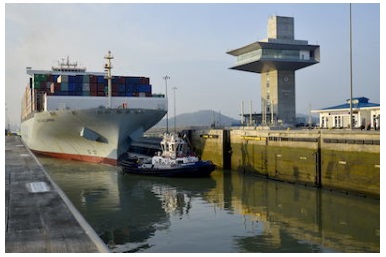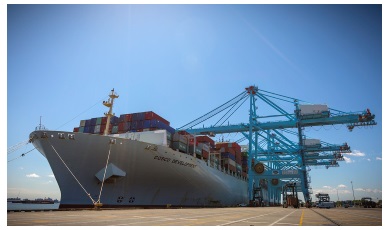
COSCO Development transiting the Panama Canal en route to the Port of Virginia
Photo/Panama Canal Authority
Virginia Welcomes Its Biggest Container Vessel Ever: The 13,000-TEU COSCO Development

COSCO Development transiting the Panama Canal en route to the Port of Virginia
Photo/Panama Canal Authority
The Port of Virginia® welcomed its largest containership ever with the May 4 docking of COSCO Development at Virginia International Gateway (VIG).
Delivered in 2011, COSCO Development has a length overall of 366 meters/1,201 feet, beam of 48.2 meters/158 feet, draft of 14.5 meters/48 feet, and deadweight of 140,609 metric tons. At 13,092-TEUs, its container capacity is nearly a third greater than that of the port’s previous record holder, the 10,000-TEU MOL Benefactor, which called Norfolk International Terminals (NIT) last summer.
"We’ve seen nothing like her here," said John. F. Reinhart, CEO and executive director of the Virginia Port Authority. "For years, we have been talking about the ‘next generation’ of vessels and the ‘big-ship era’. This is what we have been preparing for. The talk is over; the big ships are here."
During her 30-plus hour stay in Virginia, multiple labor shifts loaded and unloaded nearly 2,000 containers. On average, most vessels are there for 12-14 hours.
"What’s truly significant is that Virginia is this vessel’s first East Coast stop," Reinhart said. "This vessel is taking full advantage of our 50-foot channels and an expanded Panama Canal. As the ships get bigger there are corresponding cargo loads. So, our ability to quickly push these slugs of cargo inland by barge to Richmond Marine Terminal and double-stack rail to Virginia Inland Port and then into our markets in the nation’s heartland becomes even more important."
COSCO Shipping is part of the OCEAN Alliance, which also includes CMA-CGM, Evergreen Line and OOCL. COSCO Development operates in the alliance’s South Atlantic Express service and arrived in Virginia after transiting the expanded Panama Canal.
Deployed in this weekly Asia-to-U.S. East Coast service are 11 vessels ranging in size from 11,000 to 13,000 TEUs. The port rotation includes Hong Kong, Yantian, Ningbo, Shanghai, Panama, Virginia, Georgia and South Carolina and then back to China.
Reinhart said growing vessel sizes and accompanying cargo volumes are behind the port’s $670 million investment to increase overall annual throughput capacity by 40 percent – 1 million containers – by 2020.
Presently, heavy construction is underway at VIG and civil engineering work is nearing its start at NIT.
"We are adding capacity now so we can handle the cargo that will be coming to us on these vessels," he said. "The big ships are here — more are on the way – and they are carrying significant amounts of containers. To be sustainable and competitive for decades to come, we must be ready to accommodate that volume at our inland and water-side facilities."
